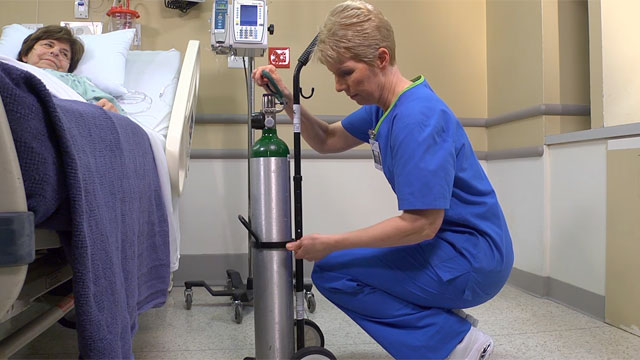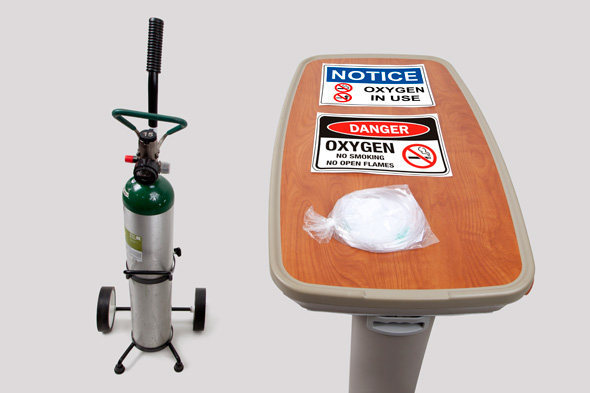Respiratory Care and Suctioning
Select a Skill:
- » Ensuring Oxygen Safety
- » Setting Oxygen Flow Rates
- » Applying a Nasal Cannula or Face Mask
- » Maintaining an Airway
- » Providing Tracheostomy Care
- » Performing Oropharyngeal Suctioning
- » Performing Nasotracheal and Nasopharyngeal Suctioning
Take the Review Test:

Safety
- Treat oxygen therapy as a medication. Use it only when indicated, at the flow rate ordered.
- Ensure that the patient has no contraindication to oxygen therapy, such as elevated PaCO2 (hypercarbia), which puts the patient at increased risk for respiratory failure.
- Check all oxygen equipment for safety and function at least once per shift, and monitor more frequently under circumstances in which oxygen concentration can vary, such as when using a hood or a high-flow device.
- Do not interrupt oxygen therapy during patient transport.
- Oxygen is highly combustible; reinforce education regarding the risk of flammability.
Equipment
(Roll cursor over items to see labels)

Oxygen nasal cannula and tubing (oxygen delivery device)
Oxygen flow meter
Oxygen source
"Oxygen in Use" room sign
"No Smoking" room sign
Holder for oxygen cylinder
Delegation
The skills of respiratory assessment and evaluation of the patient’s response to oxygen therapy cannot be delegated to nursing assistive personnel (NAP). Oxygen is a medication, and medication administration cannot be delegated to NAP. Before delegating related skills, be sure to inform NAP of the following:
- Emphasize the need to follow all safety guidelines.
- Discuss how the oxygen therapy system is set up and the need to report any differences to you.
- Instruct NAP to immediately correct or report any safety hazards.
Preparation
- Review the patient’s medical record for the health care provider’s order for oxygen. Note the delivery method, flow rate, and duration of oxygen therapy.
- Assess the patient’s and family’s or caregiver’s knowledge and understanding of safe oxygen therapy at home.
Follow-up
- Provide education to the patient and family about home oxygen therapy, proper use of the equipment, and the importance of complying with safety measures.
- Teach the patient and family to place an “Oxygen in Use” sign on the door at home and to keep oxygen delivery systems at least 10 feet away from any open flames.
- Evaluate the connection of the tubing to the oxygen device to make sure it is secure.
- Observe the patient for signs of hypoxia or adverse reactions, and report such signs to the physician so that oxygen therapy can be adjusted as needed.
Documentation
- Record the method of oxygen delivery and flow rate.
- Document the patient’s response to oxygen therapy.
- Record the dates of your patient teaching sessions about safe home oxygen therapy. Describe the content covered, and note the patient’s understanding of the safety guidelines presented.
- Document your notification of the health care provider about any signs of hypoxia or adverse reactions. Note any change to oxygen therapy, if prescribed.
Review Questions
1. What would the nurse do first when preparing to begin oxygen therapy for a patient?
 Educate the NAP about the oxygen orders.
Educate the NAP about the oxygen orders. Review the medical prescription for delivery method and flow rate.
Review the medical prescription for delivery method and flow rate. Place a “No Smoking” sign outside of the hospital room.
Place a “No Smoking” sign outside of the hospital room. Ensure that suction equipment is present in the room.
Ensure that suction equipment is present in the room.
2. When preparing the patient’s environment for safe oxygen therapy, which intervention is a priority to minimize the patient’s risk for injury?
 Place appropriate signage to alert staff and visitors to the presence of oxygen in the patient’s room.
Place appropriate signage to alert staff and visitors to the presence of oxygen in the patient’s room. Instruct nursing assistive personnel (NAP) to immediately correct or report safety hazards.
Instruct nursing assistive personnel (NAP) to immediately correct or report safety hazards. Inspect all electrical equipment in the patient’s room for the presence of safety-check tags.
Inspect all electrical equipment in the patient’s room for the presence of safety-check tags. Ensure that the patient receives the prescribed amount of oxygen via the appropriate method.
Ensure that the patient receives the prescribed amount of oxygen via the appropriate method.
3. When a patient is receiving oxygen at home, which instruction to the family would help them understand how to use the oxygen safely?
 Increase the oxygen level as needed for the patient’s comfort.
Increase the oxygen level as needed for the patient’s comfort.  Store extra oxygen cylinders horizontally.
Store extra oxygen cylinders horizontally.  Place a “No Smoking” sign at the entrance to the house.
Place a “No Smoking” sign at the entrance to the house.  Keep oxygen 5 feet (about 1.5 meters) away from anything that could generate a spark.
Keep oxygen 5 feet (about 1.5 meters) away from anything that could generate a spark.
4. What would the nurse do first when preparing to educate the patient about safe administration of oxygen therapy at home?
 Evaluate the patient’s understanding of the combustible nature of oxygen.
Evaluate the patient’s understanding of the combustible nature of oxygen. Arrange for a capable family member to be present during the initial discussion.
Arrange for a capable family member to be present during the initial discussion. Collect written information to present to the patient as supplemental instructional materials.
Collect written information to present to the patient as supplemental instructional materials. Assess the patients emotional readiness and physical ability to provide autonomous care.
Assess the patients emotional readiness and physical ability to provide autonomous care.
5. Which statement by the patient would indicate that he or she understands the safe use of oxygen?
 “The nurse told me that my oxygen saturation must be maintained at 85% or above.”
“The nurse told me that my oxygen saturation must be maintained at 85% or above.” “I know that oxygen is a medication I can adjust whenever I need to.”
“I know that oxygen is a medication I can adjust whenever I need to.”  “I’ll alert the nurse immediately if I have any increased difficulty breathing.”
“I’ll alert the nurse immediately if I have any increased difficulty breathing.” “I often experience difficulty breathing for no apparent reason, but that is expected.”
“I often experience difficulty breathing for no apparent reason, but that is expected.”
You have completed the Review Questions for this skill. To take the Review again select the Start Over button. To proceed to another skill select from the dropdown menu. Select the Home or Back button to proceed to the next section.

